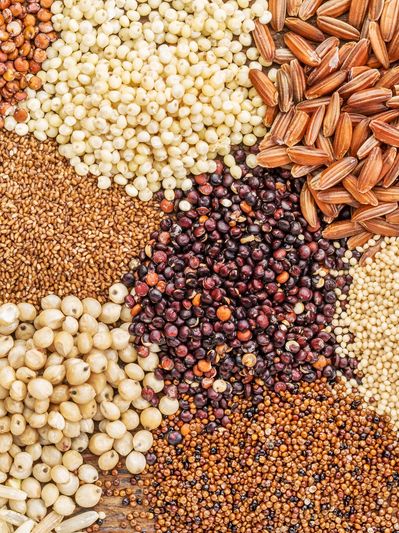Superfood grains (gluten-free)

Over time, I’ve grown to appreciate the incredible variety of gluten-free whole grains - not just for their nutrition, but for the cultural histories and flavors they bring to the table.
Quinoa is one of my staples. It’s naturally gluten-free and a complete protein, meaning it contains all nine essential amino acids - something rare in plant-based foods. It’s also rich in fiber, iron, and magnesium, which support digestion, energy production, and muscle function. I often enjoy it cooked as a side dish at dinner, but it also works well in salads or as a base for veggie bowls.
Amaranth, another complete protein, was once the sacred grain of the ancient Aztecs. Its tiny seeds have a nutty flavor that becomes even more pronounced if you toast them before cooking. I sometimes swap amaranth for quinoa to add variety and texture to my meals.
Teff, a tiny grain from Ethiopia, has a long tradition as a staple food there, particularly in injera bread. It’s naturally gluten-free and rich in iron, calcium, and protein - making it great for energy and bone health. Teff is also environmentally friendly, requiring little water to grow. Its mild, nutty taste blends easily into porridge, baked goods, or grain bowls. Learn more about its fascinating history here.
Buckwheat - despite its name - contains no wheat at all. It’s part of the rhubarb family and is naturally gluten-free. Roasted buckwheat, known as kasha, has a deep, earthy flavor. While not always labeled a “superfood,” it’s still an excellent source of B vitamins, fiber, iron, magnesium, phosphorus, and zinc.
Millet is another gluten-free grain worth exploring. While many people first encounter it as birdseed, it’s actually a delicious, versatile grain for humans too. It’s high in B vitamins, magnesium, and phosphorus, and offers more protein than corn or rice. Its mild flavor makes it an easy addition to both sweet and savory dishes.
Sorghum stands out for its high levels of anthocyanins - the same powerful antioxidants found in blueberries. It’s also a good source of fiber, B vitamins, iron, and potassium. Its slightly chewy texture and mild taste work well in soups, salads, or as a rice substitute.
Brown rice and other unrefined varieties like black, purple, and red rice offer far more nutrients, flavor, and texture than refined white rice. Because they retain their bran and germ, these colorful rice types provide fiber, antioxidants, and minerals, making them a more nourishing choice.
I’ve found that rotating these grains not only keeps meals interesting but also diversifies the nutrients I’m getting. Each grain carries its own history, taste, and set of benefits - reminding me that variety in food is just as important for joy as it is for health.
Other related alternative grains at https://gluten.org/2019/10/17/gluten-free-grains/
This website uses cookies.
We use cookies to analyze website traffic and optimize your website experience. By accepting our use of cookies, your data will be aggregated with all other user data.
